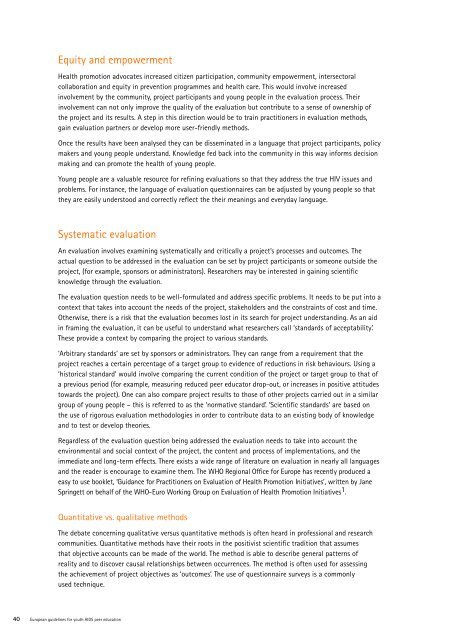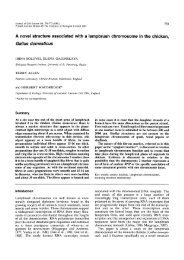European guidelines for youth AIDS peer education - University of ...
European guidelines for youth AIDS peer education - University of ...
European guidelines for youth AIDS peer education - University of ...
- No tags were found...
Create successful ePaper yourself
Turn your PDF publications into a flip-book with our unique Google optimized e-Paper software.
Equity and empowermentHealth promotion advocates increased citizen participation, community empowerment, intersectoralcollaboration and equity in prevention programmes and health care. This would involve increasedinvolvement by the community, project participants and young people in the evaluation process. Theirinvolvement can not only improve the quality <strong>of</strong> the evaluation but contribute to a sense <strong>of</strong> ownership <strong>of</strong>the project and its results. A step in this direction would be to train practitioners in evaluation methods,gain evaluation partners or develop more user-friendly methods.Once the results have been analysed they can be disseminated in a language that project participants, policymakers and young people understand. Knowledge fed back into the community in this way in<strong>for</strong>ms decisionmaking and can promote the health <strong>of</strong> young people.Young people are a valuable resource <strong>for</strong> refining evaluations so that they address the true HIV issues andproblems. For instance, the language <strong>of</strong> evaluation questionnaires can be adjusted by young people so thatthey are easily understood and correctly reflect the their meanings and everyday language.Systematic evaluationAn evaluation involves examining systematically and critically a project’s processes and outcomes. Theactual question to be addressed in the evaluation can be set by project participants or someone outside theproject, (<strong>for</strong> example, sponsors or administrators). Researchers may be interested in gaining scientificknowledge through the evaluation.The evaluation question needs to be well-<strong>for</strong>mulated and address specific problems. It needs to be put into acontext that takes into account the needs <strong>of</strong> the project, stakeholders and the constraints <strong>of</strong> cost and time.Otherwise, there is a risk that the evaluation becomes lost in its search <strong>for</strong> project understanding. As an aidin framing the evaluation, it can be useful to understand what researchers call ‘standards <strong>of</strong> acceptability’.These provide a context by comparing the project to various standards.‘Arbitrary standards’ are set by sponsors or administrators. They can range from a requirement that theproject reaches a certain percentage <strong>of</strong> a target group to evidence <strong>of</strong> reductions in risk behaviours. Using a‘historical standard’ would involve comparing the current condition <strong>of</strong> the project or target group to that <strong>of</strong>a previous period (<strong>for</strong> example, measuring reduced <strong>peer</strong> educator drop-out, or increases in positive attitudestowards the project). One can also compare project results to those <strong>of</strong> other projects carried out in a similargroup <strong>of</strong> young people – this is referred to as the ‘normative standard’. ‘Scientific standards’ are based onthe use <strong>of</strong> rigorous evaluation methodologies in order to contribute data to an existing body <strong>of</strong> knowledgeand to test or develop theories.Regardless <strong>of</strong> the evaluation question being addressed the evaluation needs to take into account theenvironmental and social context <strong>of</strong> the project, the content and process <strong>of</strong> implementations, and theimmediate and long-term effects. There exists a wide range <strong>of</strong> literature on evaluation in nearly all languagesand the reader is encourage to examine them. The WHO Regional Office <strong>for</strong> Europe has recently produced aeasy to use booklet, ‘Guidance <strong>for</strong> Practitioners on Evaluation <strong>of</strong> Health Promotion Initiatives’, written by JaneSpringett on behalf <strong>of</strong> the WHO-Euro Working Group on Evaluation <strong>of</strong> Health Promotion Initiatives 1 .Quantitative vs. qualitative methodsThe debate concerning qualitative versus quantitative methods is <strong>of</strong>ten heard in pr<strong>of</strong>essional and researchcommunities. Quantitative methods have their roots in the positivist scientific tradition that assumesthat objective accounts can be made <strong>of</strong> the world. The method is able to describe general patterns <strong>of</strong>reality and to discover causal relationships between occurrences. The method is <strong>of</strong>ten used <strong>for</strong> assessingthe achievement <strong>of</strong> project objectives as ‘outcomes’. The use <strong>of</strong> questionnaire surveys is a commonlyused technique.40 <strong>European</strong> <strong>guidelines</strong> <strong>for</strong> <strong>youth</strong> <strong>AIDS</strong> <strong>peer</strong> <strong>education</strong>
















